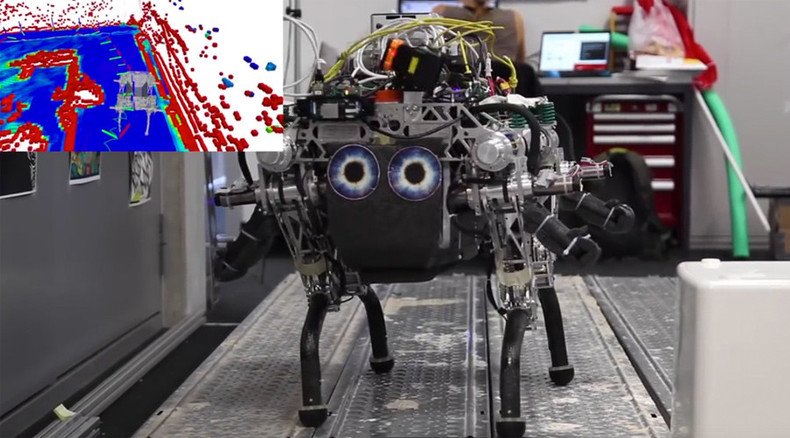Walking robot uses drone to help traverse tricky terrain (VIDEO)

Swiss-based scientists have developed a robot double act in which a hexacopter helps a dog-like, land-based robot find its way around obstacles. The technology could be deployed in space exploration or warfare.
“Flying and walking robots can use their complementary features in terms of viewpoint and payload capability to the best in a heterogeneous team,” says an intro to a video posted on YouTube by the team at ETH Zurich, Switzerland’s leading tech research institution.
In the simulation, a hexacopter with a specialized mounted camera that creates a three-dimensional image of the area below, is sent out ahead of the walking robot, producing a “consistent map of the landmarks of the area.”
The data is then sent to the four-legged robot, nicknamed StarlETH, which uses it to plot a course to its destination. As it walks through the area the “map is continuously updated with distance measurements from an onboard laser range sensor.”
“This allows the legged robot to safely navigate towards the goal while taking into account any changes in the environment,” boasts the Autonomous Systems Lab (ASL) at the college, which has been developing robotic designs for nearly two decades.
Creating stable quadruped robots, which can navigate any terrain is a challenge, as any Star Wars fans can attest. ASL has posted videos in which StarlETH uses different gaits to adapt to the ground below, but with its limited sightlines, it is still likely to get stuck at anything above a garden wall, unsure where to go next. Using a companion drone has overcome this issue, and a demonstration released last month showed StarlETH powering a quadcopter connected to it through a lead.
Producing even a prohibitively expensive quadruped that can operate in the outside world is likely to reap rewards.
Improved stability and navigation would allow better reconnaissance on the surface of alien moons and planets, as more craft are sent out in the coming years, though using a drone in, for example, Mars’ thin atmosphere will require different propulsion technologies.
Back on Earth, Boston Dynamics, a US company that has produced a quadruped named Spot, has seen its innovation deployed alongside marines in training. Spot, who rose to internet fame when it was kicked by a scientist in a demo video, only to respond in an eerily lifelike fashion, was sent in to scout hostiles in a warehouse, before soldiers clear out the building. Quadrupeds are likely to become common tools alongside existing drones and bomb disposal robots. US future-tech agency Darpa has also trialed quadruped attachments on the undersides of helicopters, to enable landing on uneven surfaces.
The team at ETH Zurich plans to present its own findings at the IEEE International Conference on Robotics and Automation, a leading robotics summit, in Stockholm, Sweden, in May next year.












